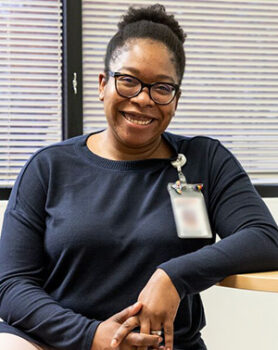 There is growing concern about social media’s effects on mental health, especially for kids.
There is growing concern about social media’s effects on mental health, especially for kids.
In January, Seattle Public Schools filed a lawsuit against Facebook, Instagram, TikTok, Snapchat and YouTube for their roles in “creating a youth mental health crisis.” In February, the Senate Judiciary Committee held a hearing about the issue, with some senators demanding social media companies be held accountable.
How does social media affect mental health? Are the concerns valid? And if so, what can parents and other adults do to protect kids (and themselves)?
Dr. Yolanda Evans, co-chief of the Division of Adolescent Medicine and a principal investigator in the Center for Child Health, Behavior and Development at Seattle Children’s, sees the effects of social media firsthand.
In this Q & A with Dr. Evans, On the Pulse shares her expertise and provides helpful resources for families and caregivers.
How bad is social media for youth mental health?
Like anything, there are positives and downsides. Some of the positives are it serves as a platform for kids to have a sense of community, to connect with friends and family, and to learn about things they’re curious about.
At the same time, some studies show engagement with social media can lead to exploitation of youth. It can lead to online harassment, cyberbullying and anxiety. It can perpetuate eating disorder behavior, substance use and depression.
How does social media exacerbate things like anxiety, depression and exploitation?
Some people post pictures and videos that are not necessarily reality, but when youth see things on social media like substance use or sexual behavior, they can feel like it’s normalized and then engage in those things, too. You also can’t really get away from it — social media follows you.
Many people don’t understand that what you spend time looking at, or what you click on, is going to lead to more of that content being fed to you. That’s what the algorithms on social media platforms do, and it creates an echo chamber of content that could be harmful.
It’s also hard to know what’s true and what’s misinformation — who’s a credible source and who’s not.

How can adults help children and adolescents use social media in healthy ways?
There are many great resources. One is a family media plan from the American Academy of Pediatrics, which focuses on how to become educated consumers and set boundaries as a family.
It includes things like having screen-free areas in the home or screen-free times or having a universal charging station so kids can’t bring devices into their bedroom all night. Common Sense Media is another good resource.
It comes down to the family, too, and setting expectations. Maybe devices can be used in common spaces but not in kids’ bedrooms when they’re younger.
Talk to your kids about the content they’re seeing. Ask questions like, “What are you into right now? What are your friends using to communicate, and how does that platform work?”
Approach it with curiosity so you can learn about the things kids are engaging with. Then when something is concerning, you can say, “It looks like people can chat with anybody on that platform. How does that impact you?”
Also, parents can provide safety tips like teaching their kids to turn off their location and not share personal information. When thinking about what platforms you’re going to allow your child to use, look at the fine print of the agreement for what strategies they use to regulate things.
Building trust is important. If someone asks your kid to send a picture or share their location, you want your kid to talk to you before they do anything. Ensuring clear expectations and consequences beforehand helps your child know when you might intervene and when and how they can come to you with questions.
What’s the appropriate age for kids to start interacting on social media?
This is the trillion-dollar question! It’s also an individualized question.
As parents, we can look at their level of responsibility and what our kids are taking ownership of. Are they cleaning their own room? Turning in their homework? Are they having conversations with friends that are respectful? If a child isn’t ready to engage in these types of developmental tasks, they may not be ready to navigate having a personal device like a cell phone or use social media.
Parents should gauge their child’s development and incorporate some of those safety tips mentioned. Then when you allow them to have a phone or device, build clear expectations like, “Here’s when we’re going to use it. Here are the things we’re going to do as a family.” Fortunately, with technology now, we can set up a family portal ID so parents have a bit of oversight. But recognize kids sometimes know how to get around those things.
What are the warning signs that a child may be experiencing depression, anxiety or other mental health concerns?
Look for signs of withdrawal. Are they disengaging from things that used to give them joy? Are they isolating? Are you seeing changes in their mood or behavior like irritability, anger, sadness, frustration or crying? Are they engaging in self-injury? Are you seeing changes in their diet? These are all warning signs.
Consider any sign of online harassment — are they sharing that they’re being targeted online by people saying negative things, or are there myths or rumors about them? Again, ask what platforms they’re using, and check those platforms to see if there are rules around blocking people or reporting things. Also, ask your kids if they’ve ever had to block anyone — that could be a red flag for potential issues.
How can adults model good social media behavior and protect ourselves from social media’s downsides?
Adults should similarly be mindful that content keeps getting fed to us and we can’t necessarily believe everything we read.
Think about the source and what their credentials are. Is information coming from someone who has the knowledge to share it? When clicking on links, do they end in .net and .com, which can include misinformation, or are they more credible sources like .edu and .gov? That can provide a sense of whether it is or isn’t an organization to trust.
Are people with different opinions sharing information on the platform, or does everybody agree with each other? Differences in perspective are helpful to tease out how something is impacting others, where someone stands and how they want to take the information in. These are things to be mindful of as adults, too.
Resources:
- Common Sense Media: Social Media Hub
- American Academy of Pediatrics: Family Media Plan
- Seattle Children’s Mental Health Resources page
- Social Media Guidelines: 13 and Older
- Child Mind Institute: How Using Social Media Affects Teenagers
- American Academy of Pediatrics: Social Media and Your Child’s Mental Health: What the Research Says
- Pew Research Center: Teens, Social Media and Technology 2022

